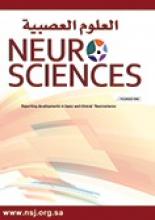Saudi clinical practice guidelines for the treatment and prevention of migraine headache

ABSTRACT
Objective: To develop clinical practice guidelines based on evidence based medicine on the use of abortive and preventive therapies for managing migraine headaches. We formulated these guidelines to offer evidence-based recommendations to improve the knowledge of physicians, healthcare professionals, and policymakers in migraine headache management.
Method: A panel of 11 experts from different sectors in Saudi Arabia approved 26 questions on abortive and preventive therapies for migraines. To develop each question, we searched “PubMed” and “Cochrane Library” databases for recent relevant systematic reviews published between 2013 and 2024. We employed the Grading Recommendations, Assessment, Development, and Evaluation methodological approach to ensure the certainty of the collated evidence and to formulate the recommendations. The expert panel voted electronically on each recommendation, and a consensus was defined as >70% agreement.
Results: We formulated a total of 26 recommendations. Of these, 14 are focused on abortive therapy for acute migraine attacks, whereas 12 are focused on the prevention of episodic or chronic migraines. These guidelines strongly recommend the use of paracetamol and ibuprofen as the first-line treatment for mild to moderate migraine. Furthermore, we concluded that propranolol should be considered as the first-line preventive intervention for migraine.
Conclusion: The Saudi clinical practice guidelines offer systematically validated recommendations of migraine headaches in adults. The recommendations are potentially beneficial for all healthcare professionals managing patients with migraine headaches.
Footnotes
Disclosure. Authors have no conflict of interests, and the work was not supported or funded by any drug company.
- Copyright: © Neurosciences
Neurosciences is an Open Access journal and articles published are distributed under the terms of the Creative Commons Attribution-NonCommercial License (CC BY-NC). Readers may copy, distribute, and display the work for non-commercial purposes with the proper citation of the original work.
In this issue
Jump to section
Related Articles
- No related articles found.
Cited By...
- No citing articles found.





